

· Por James
12 Best Video Conferencing Software for Remote Work in 2025
Finding the best video conferencing software is essential for staying connected, whether you're working from a home office, traveling in an RV, or navigating the realities of rural internet. A dropped call during a critical meeting or a pixelated video feed can derail productivity and cause unnecessary frustration. This guide cuts through the marketing noise to deliver a practical, in-depth analysis of the top platforms available today, focusing specifically on what matters most to remote workers and digital nomads. We've tested these tools to see how they perform under real-world conditions, including limited bandwidth and mobile 5G connections.
This resource is designed to help you make an informed decision quickly. Instead of generic feature lists, you'll find a detailed breakdown of 12 leading options, from industry giants like Zoom and Microsoft Teams to specialized alternatives like Jitsi Meet and Dialpad Meetings. For each platform, we provide a hands-on assessment covering:
- Performance: How well does it handle low-bandwidth environments?
- Key Features: What specific tools are most useful for remote collaboration?
- Pricing: A clear look at free tiers and paid plans.
- Pros & Cons: An honest evaluation tailored for travelers and rural users.
Every profile includes screenshots for a visual reference and direct links to get you started immediately. We analyze the nuances of each service, so you can confidently select the software that aligns with your specific needs, budget, and connection stability. For those organizing larger remote gatherings, a detailed virtual event planning checklist can help you structure the entire process, ensuring you leverage your chosen platform's features for a seamless experience. Let's dive in and find the right tool to keep you connected, no matter where you are.
1. Zoom
Zoom has become nearly synonymous with video conferencing, and for good reason. It established its dominance through a reputation for reliability and an intuitive interface that just works, even for less tech-savvy users. For RVers and remote workers dealing with fluctuating internet conditions, Zoom’s performance is a key differentiator, often maintaining a stable connection where other platforms might falter. Its ability to dynamically adjust video quality to preserve audio is a lifesaver on weaker 5G or rural campground Wi-Fi networks.
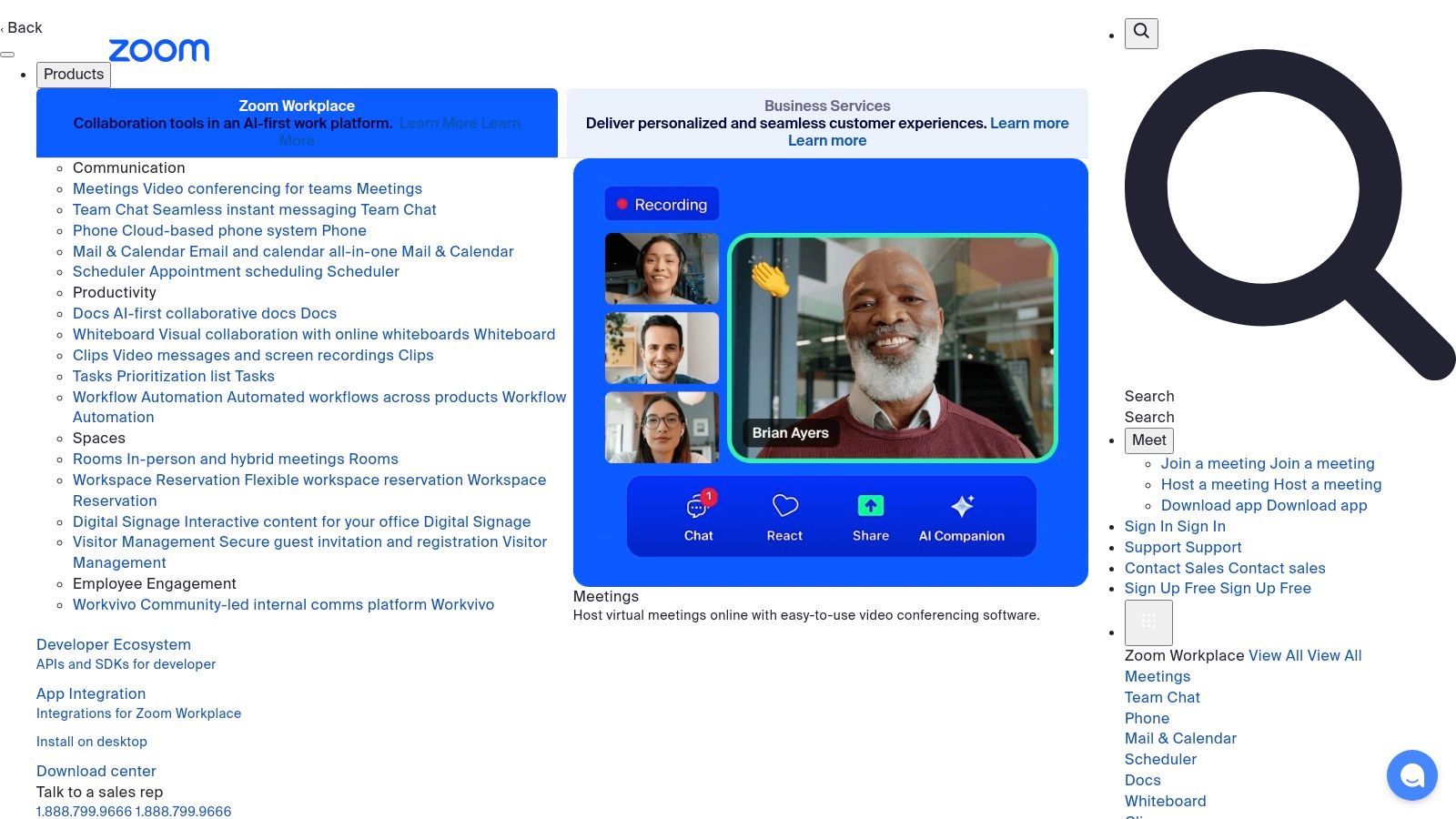
This platform excels at scaling from a simple one-on-one chat to a large-scale webinar with hundreds of participants. The free plan is generous, offering unlimited one-on-one meetings, though group meetings are capped at 40 minutes. For those who need more, its paid tiers unlock powerful features that make it one of the best video conferencing software options available.
Key Features & Performance
- HD Video & Audio: Consistently clear quality that adapts to your connection speed. You can learn more about the required internet speeds for a stable Zoom call.
- Breakout Rooms: Invaluable for remote team collaboration, allowing you to split a large meeting into smaller, focused discussion groups.
- Recording & Transcription: Easily save meetings to the cloud or your device, with AI-powered transcription for quick reference.
Pricing & Access
- Free Plan: Unlimited 1:1 meetings, 40-minute limit on group meetings (up to 100 participants).
- Pro Plan (Starts at $15.99/user/month): Removes the 40-minute limit, adds cloud recording, and includes social media streaming.
- Business Plan (Starts at $19.99/user/month): Adds company branding, single sign-on (SSO), and managed domains.
Our Take: Zoom remains the top choice for users who prioritize stability and ease of use. While the free plan's 40-minute limit can be frustrating for group calls, its performance on inconsistent internet connections makes it an essential tool for digital nomads and rural remote workers.
2. Microsoft Teams
For businesses and individuals deeply embedded in the Microsoft 365 ecosystem, Microsoft Teams is a powerhouse of collaboration. It goes beyond simple video calls, integrating chat, file sharing, and project management into a single, unified hub. This makes it an exceptional choice for remote teams who need to stay organized and productive. While it can be more resource-intensive than some competitors, its comprehensive feature set provides a seamless workflow, eliminating the need to juggle multiple applications.
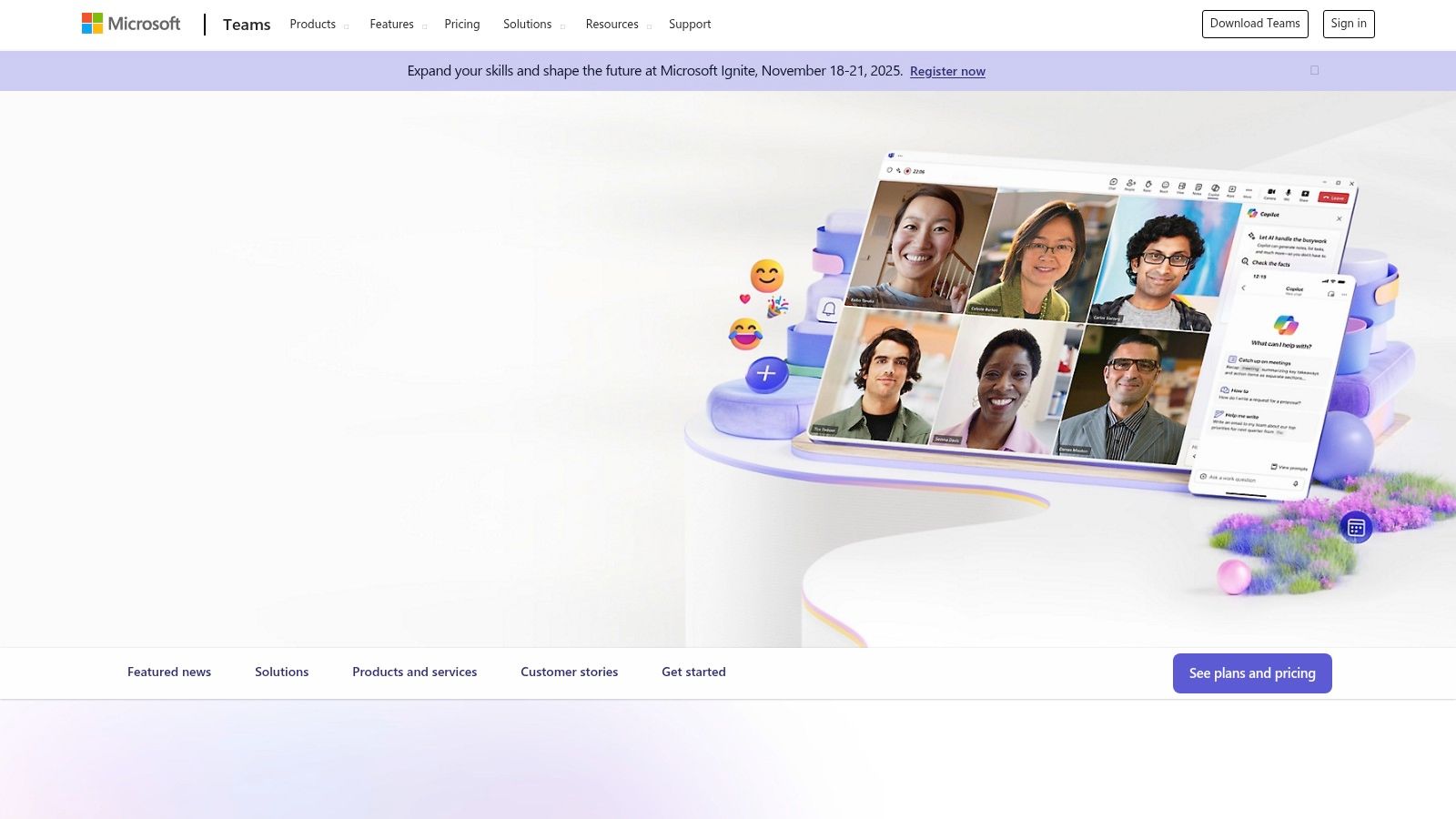
Teams shines in its ability to create persistent "channels" for different projects or departments, keeping conversations and files neatly organized. Its deep integration with apps like Word, Excel, and SharePoint allows for real-time document collaboration directly within a meeting or chat. For a deeper look at how Teams fits into a digital nomad's toolkit, explore our guide on essential remote work apps.
Key Features & Performance
- Seamless Office 365 Integration: Edit Word docs, PowerPoint slides, and Excel sheets with colleagues in real-time during a call.
- Team Channels: Organize communication by project, topic, or team, creating a permanent, searchable record of conversations and files.
- Together Mode: Places participants in a shared virtual background, like an auditorium, to make meetings feel more engaging and less like a grid of faces. Beyond core video conferencing, you can explore its Microsoft Teams dictation features for enhanced note-taking during meetings.
Pricing & Access
- Free Plan: Unlimited group meetings for up to 60 minutes with up to 100 participants, plus 5 GB of cloud storage.
- Microsoft 365 Business Basic (Starts at $6.00/user/month): Extends meeting duration to 30 hours, increases participant limit to 300, and adds 1 TB of storage.
- Microsoft 365 Business Standard (Starts at $12.50/user/month): Includes all Basic features plus desktop versions of Office apps and webinar hosting.
Our Take: Microsoft Teams is the best video conferencing software for organizations committed to the Microsoft suite. The learning curve is steeper than Zoom's, but the payoff is a powerful, all-in-one collaboration tool that streamlines workflows. Its comprehensive free plan is also one of the most generous available.
3. Google Meet
For users deeply embedded in the Google ecosystem, Google Meet is a seamless and accessible choice. Its greatest strength lies in its native integration with Google Workspace, allowing you to create and join meetings directly from Google Calendar or a Gmail invite. This browser-based approach eliminates the need for software installation, making it incredibly convenient for quick calls and for inviting guests who may not have dedicated video conferencing apps installed.
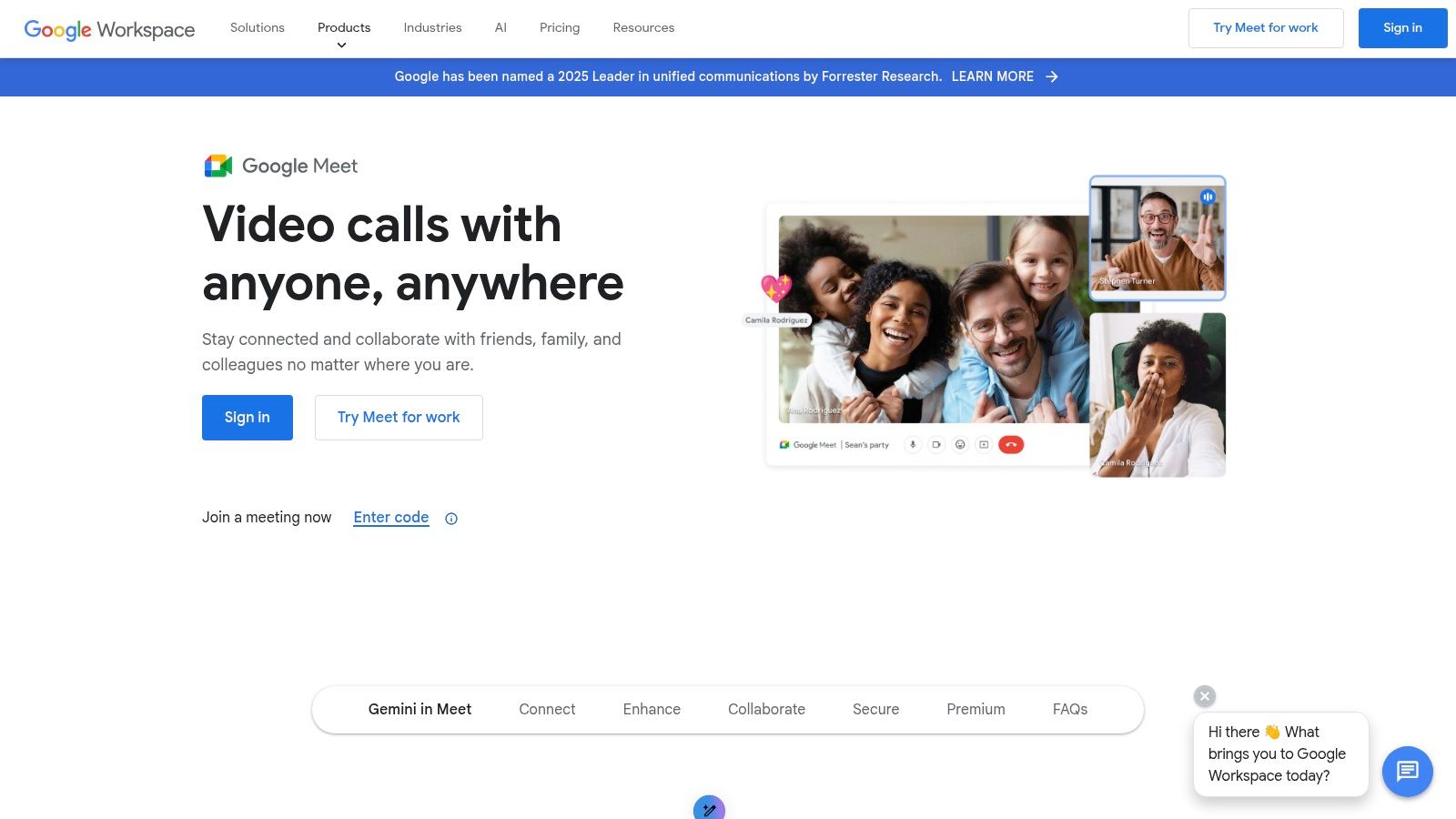
While it may not boast the extensive feature set of specialized competitors, its simplicity is a significant advantage. Performance on mobile networks is generally reliable, and its clean interface ensures that even first-time users can join and participate without confusion. This makes it an excellent option for those who prioritize ease of use and quick access over advanced functionality, aligning well with the fast-paced needs of those who work remotely and travel.
Key Features & Performance
- Google Workspace Integration: Effortlessly schedule and join meetings from Google Calendar and Gmail.
- Live Captions: Real-time, AI-powered captions improve accessibility and understanding during meetings.
- Browser-Based Access: No downloads required for participants, which simplifies the process of joining a meeting.
Pricing & Access
- Free Plan: Meetings with up to 100 participants, with a 60-minute time limit on group calls.
- Google Workspace Individual (Starts at $7.99/month): Extends meeting length to 24 hours, adds call recording, and includes noise cancellation.
- Google Workspace Business Plans (Starts at $6/user/month): Increases participant limits (up to 1,000) and adds advanced security features.
Our Take: Google Meet is the best video conferencing software for individuals and teams who live in their Google Workspace. Its unbeatable convenience and simple interface are perfect for straightforward meetings, though power users may find its feature set limiting compared to other platforms.
4. Cisco Webex
Cisco Webex is a powerhouse in the video conferencing space, built on a foundation of enterprise-grade security and reliability. For remote workers who handle sensitive information or require high-performance collaboration tools, Webex offers a secure and feature-rich environment. Its video and audio quality are exceptional, featuring advanced noise cancellation and speech enhancement that can significantly improve clarity on less-than-perfect connections, a common challenge for RVers using mobile hotspots.

While often seen as a corporate tool, Webex has a capable free plan and scales effectively for businesses of all sizes. Its deep integration with other productivity suites like Microsoft 365 and Google Workspace makes it a seamless addition to existing workflows, solidifying its place as one of the best video conferencing software choices for professionals. The interface, while powerful, can present a steeper learning curve than some alternatives.
Key Features & Performance
- Noise Cancellation & Speech Enhancement: AI-powered audio features filter out background noise and enhance voice clarity, crucial for calls from a noisy campground or vehicle.
- Interactive Whiteboarding: Facilitates real-time brainstorming and visual collaboration with a shared digital canvas.
- End-to-End Encryption: Provides robust, multi-layer security for all meetings, protecting sensitive conversations and data.
Pricing & Access
- Free Plan: Meetings up to 40 minutes for up to 100 attendees, includes screen sharing and interactive whiteboarding.
- Meet Plan (Starts at $15/user/month): Removes the time limit, adds meeting recordings with transcription, and allows for alternate hosts.
- Suite Plan (Starts at $25/user/month): Combines meetings with calling and messaging capabilities for a full collaboration suite.
Our Take: Webex is the ideal choice for remote professionals and businesses prioritizing security and advanced audio performance. While its interface may feel complex initially, its ability to deliver crystal-clear audio even in challenging environments makes it a top-tier option for serious remote work.
5. GoTo Meeting
GoTo Meeting is a long-standing player in the professional video conferencing space, known for its security and enterprise-grade features. It positions itself as a premium, reliable tool for businesses that require high-quality virtual collaboration. For remote professionals who need a dependable platform for client-facing calls or internal team meetings, GoTo Meeting offers robust performance, even when dealing with the unpredictable nature of cellular or campground Wi-Fi networks.
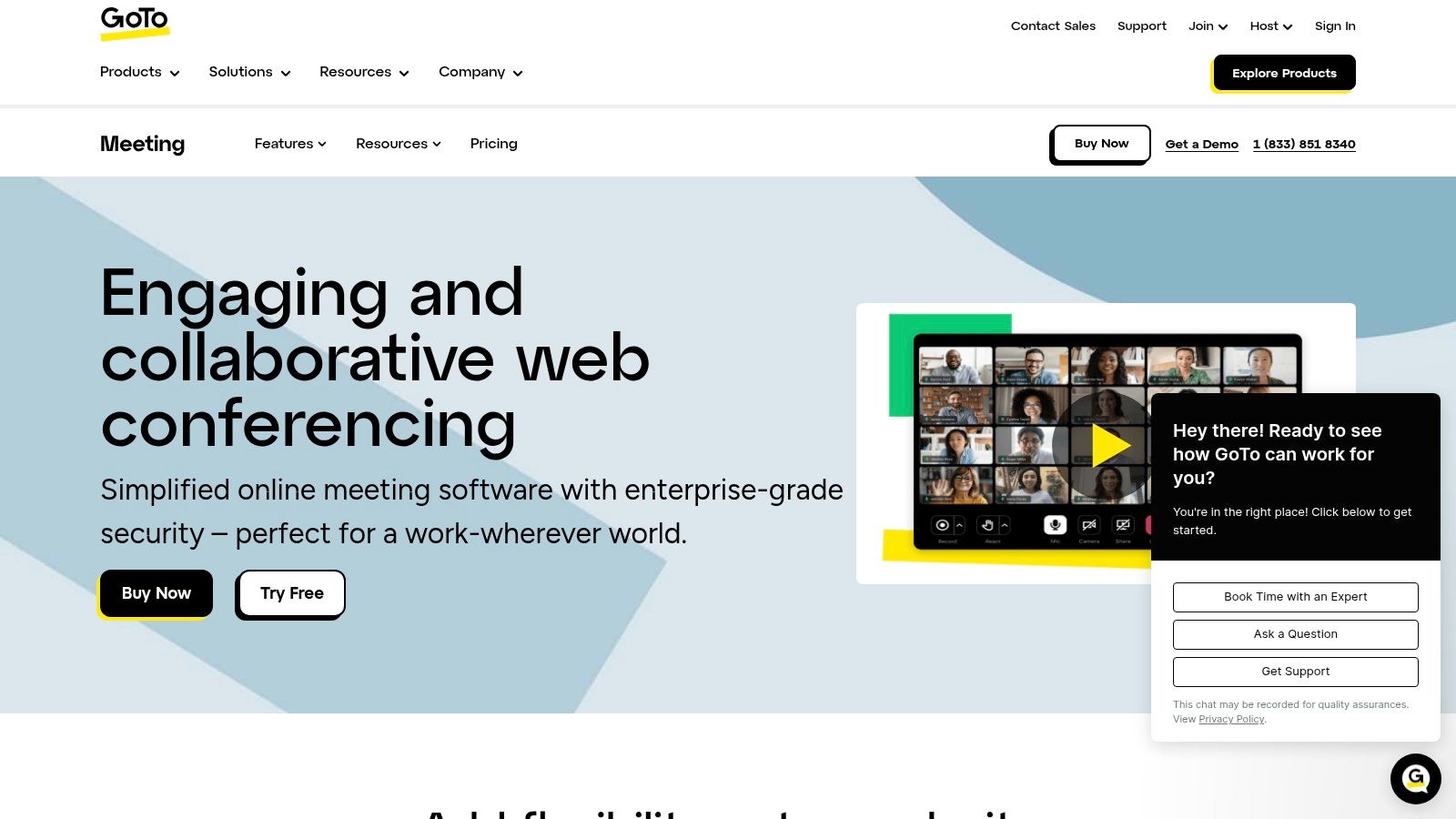
While it doesn't offer a free plan like many competitors, its focus is on providing a comprehensive feature set from the get-go. This makes it one of the best video conferencing software options for users who are ready to invest in a dedicated, professional-grade solution without feature limitations that interrupt workflow.
Key Features & Performance
- Screen Sharing & Drawing Tools: Go beyond basic screen sharing with collaborative drawing tools, perfect for interactive presentations and brainstorming sessions.
- Meeting Recording & Transcription: Capture meetings with unlimited cloud recording and automated transcriptions, making it easy to review key decisions.
- Mobile Apps: Fully-featured mobile apps for iOS and Android ensure you can join or host a meeting from anywhere, a critical feature for travelers.
Pricing & Access
- Professional Plan (Starts at $12/organizer/month): Allows up to 150 participants with no time limits, screen sharing, and dial-in options.
- Business Plan (Starts at $16/organizer/month): Increases the participant cap to 250 and adds unlimited cloud recording, transcription, and drawing tools.
- Enterprise Plan (Custom Pricing): For large organizations, offering up to 3,000 participants and advanced administrative features.
Our Take: GoTo Meeting is an excellent choice for professionals and businesses who need a secure, no-fuss platform and are willing to pay for it. Its lack of a free tier is a drawback for casual users, but for anyone who relies on video calls for their livelihood, its reliability and professional toolset justify the cost.
6. RingCentral Video
RingCentral Video offers a powerful, integrated communication experience that goes beyond simple video calls. As part of a larger unified communications platform, it combines video meetings, team messaging, and a business phone system into one seamless application. For remote workers or RV-based businesses that need a professional, all-in-one solution, RingCentral provides a robust framework that keeps all communication channels connected, minimizing the need to switch between different apps.
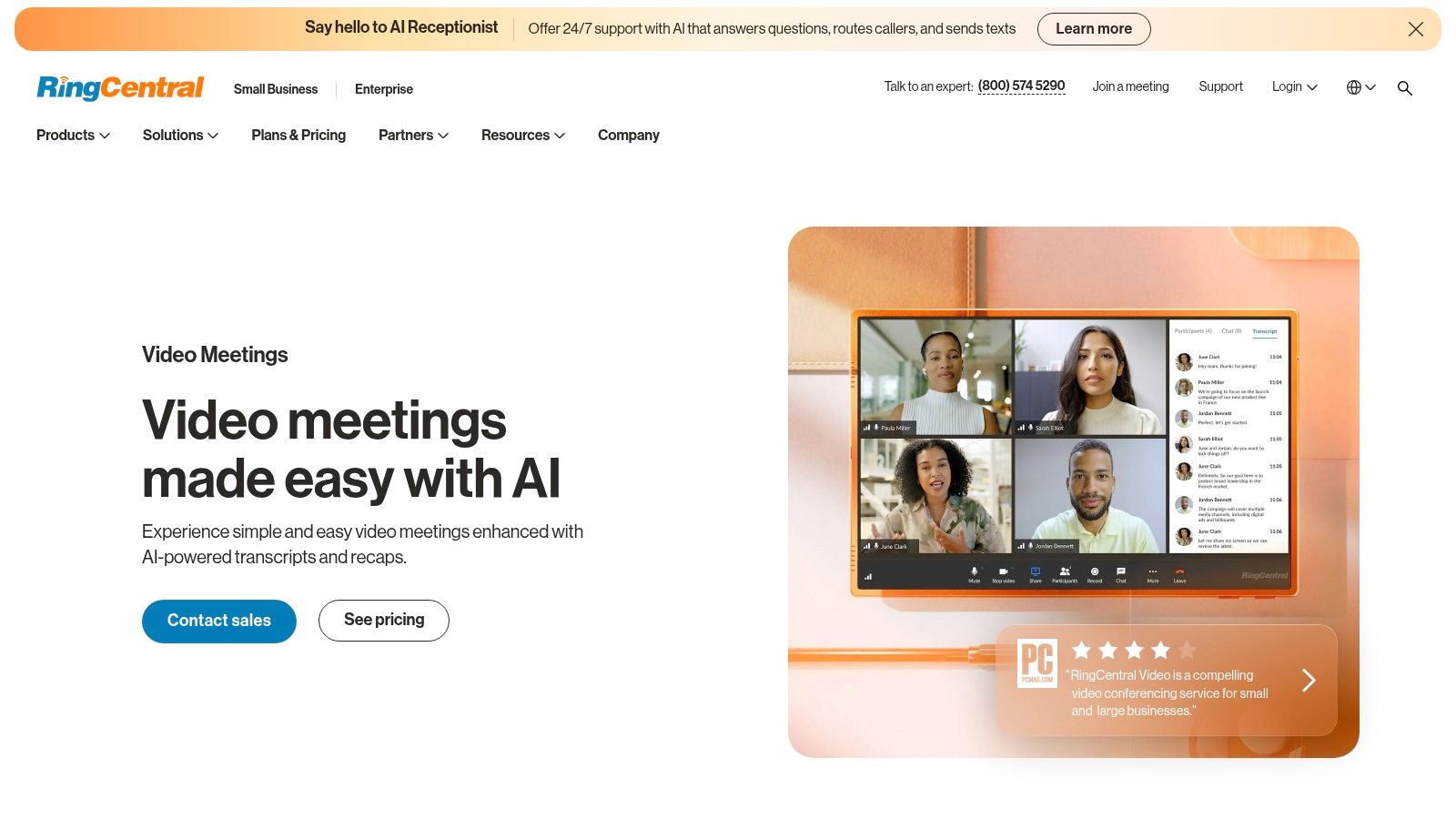
The platform is built on a foundation of high-quality video and audio, with AI-powered features like noise reduction that are particularly useful in unpredictable environments like a bustling campground or a coffee shop. While its free tier is more limited than some competitors, its strength lies in its comprehensive paid plans, which position it as one of the best video conferencing software choices for businesses seeking a unified communications hub.
Key Features & Performance
- Unified Communications: Seamlessly switch from a team message thread to a video call or a phone call within the same interface.
- HD Video & Audio: Delivers reliable, high-definition quality with advanced features like AI-powered noise reduction to filter out background distractions.
- Integrations: Deep integration with essential business tools like Microsoft 365 and Google Workspace for streamlined workflows.
- Meeting Recording & Transcripts: Capture meetings with automated, AI-generated transcriptions for easy review and action item tracking.
Pricing & Access
- Video Pro (Free): Allows meetings up to 50 minutes with up to 100 participants, includes team messaging.
- Video Pro+ ($11.99/user/month): Extends meeting duration to 24 hours, adds cloud recording, and includes advanced analytics.
- RingCentral MVP Plans: Full platform access, including business phone, starts with higher-tiered plans.
Our Take: RingCentral Video is the ideal choice for businesses and remote professionals who need more than just video conferencing. If you are looking for an integrated phone, messaging, and meeting solution, its unified platform is hard to beat. While it may be overkill for individuals, its professional features provide significant value for established remote teams.
7. BlueJeans
BlueJeans, now part of Verizon, carves out its niche in the crowded market by focusing relentlessly on audio fidelity and enterprise-grade security. Its signature feature, Dolby Voice audio, delivers exceptionally clear sound, suppressing background noise and making sure every participant is heard distinctly. This is a significant advantage for remote workers in noisy environments like a busy campground or when relying on a spotty mobile hotspot, as audio clarity often remains stable even when video quality must be reduced.
While it doesn't offer a free plan like many rivals, its paid tiers are packed with features designed for professional collaboration. For businesses or teams that need the absolute best audio experience for important client calls or internal meetings, BlueJeans presents a compelling case as one of the best video conferencing software choices, prioritizing quality over quantity.
Key Features & Performance
- Dolby Voice Audio: Provides a superior audio experience with spatial sound and advanced noise cancellation, making conversations feel more natural.
- Smart Meetings: Automated highlight reels, action-item tagging, and transcription make it easy to catch up on meetings you missed.
- Strong Security: Features like meeting lock, participant passcodes, and end-to-end encryption for secure business communications.
Pricing & Access
- Standard Plan (Starts at $12.49/user/month): Host up to 100 participants with unlimited meeting duration and 5 hours of recording.
- Pro Plan (Starts at $17.49/user/month): Increases participant limit to 150 and recording time to 25 hours, plus command center analytics.
- Enterprise Plan (Custom Pricing): For large organizations, adds features like brand customization and connection to SIP/H.323 room systems.
Our Take: BlueJeans is the go-to for users who refuse to compromise on audio quality. The lack of a free tier makes it less accessible for casual use, but for remote professionals and businesses where clear communication is non-negotiable, the investment in its Dolby-powered platform is easily justified.
8. Zoho Meeting
For businesses already invested in the Zoho ecosystem, Zoho Meeting is a natural and highly integrated choice. It stands out by offering a secure and remarkably affordable video conferencing and webinar solution that prioritizes simplicity and seamless workflow. For remote workers managing customer relationships or projects within Zoho CRM or other Zoho apps, this platform eliminates friction by embedding communication tools directly where you work, making it one of the best video conferencing software options for streamlined operations.
Zoho Meeting operates entirely within your browser, meaning attendees don't need to download any software, which is a major convenience for quick, impromptu calls with clients. While it might not have the extensive feature set of some larger competitors, its focus on core functionality and affordability makes it a compelling alternative, especially for small to medium-sized teams.
Key Features & Performance
- Deep Zoho Ecosystem Integration: Works seamlessly with Zoho CRM, Projects, and other apps, allowing you to launch meetings directly from your workflow.
- Webinar & Meeting Modes: Provides distinct tools for interactive meetings and larger, presentation-style webinars with Q&A and polling features.
- Browser-Based Access: Participants can join with a simple link, removing the barrier of software installation and updates.
- Security Controls: Features like meeting locks, moderator controls, and role-based permissions ensure your conversations remain private.
Pricing & Access
- Free Plan: Allows up to 100 meeting participants with a 60-minute time limit.
- Meeting (Starts at $3/host/month): Includes 24-hour meeting duration, cloud recording storage, and integration capabilities.
- Webinar (Starts at $19/organizer/month): Adds webinar-specific features like registration customization, polls, and source tracking.
Our Take: Zoho Meeting is the ideal choice for teams deeply embedded in the Zoho suite. Its value is less about standalone features and more about its powerful integration. While the feature set is more streamlined, its affordability and ease of use make it a practical and efficient tool for daily business communications.
9. Jitsi Meet
For those who prioritize privacy, security, and open-source principles, Jitsi Meet is an exceptional choice. It stands out as a completely free, secure, and encrypted video conferencing platform that operates directly in your browser. This eliminates the need for any software installation or even creating an account, offering unparalleled ease of access for quick, spontaneous meetings. For RVers or digital nomads who need to jump on a call without hassle, this is a significant advantage.
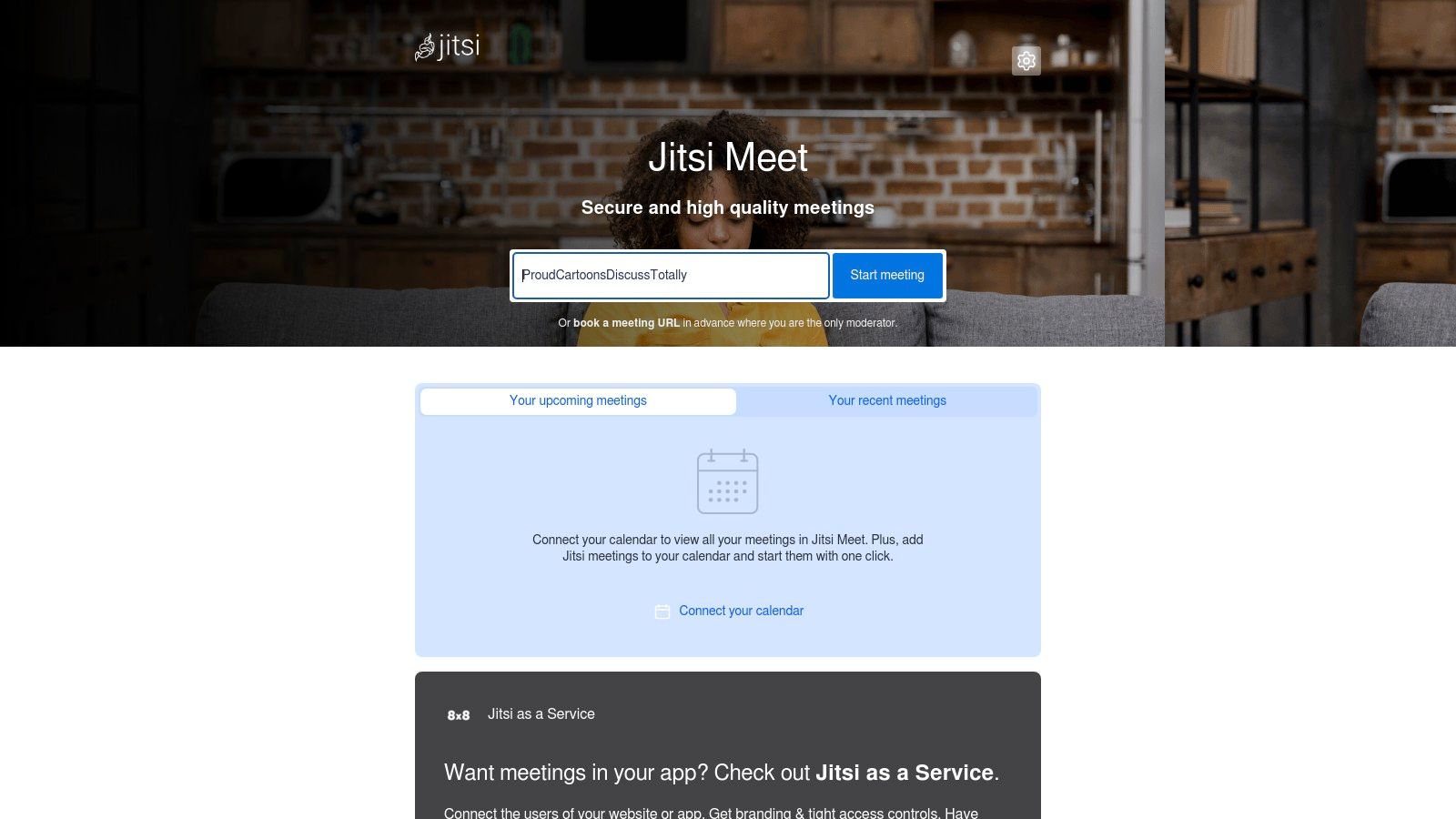
The platform’s open-source nature means it's community-driven and transparent. While the publicly available version at meet.jit.si is robust, technically inclined users can self-host their own Jitsi instance for total control over their data and infrastructure. Although it lacks some of the advanced enterprise features of paid competitors, its core functionality makes it one of the best video conferencing software options for privacy-conscious users and small teams.
Key Features & Performance
- No Account Required: Start or join meetings instantly without any sign-up process, making it incredibly fast and user-friendly.
- End-to-End Encryption: Provides a strong layer of security and privacy for all your conversations.
- Customizable URLs & Integrations: Create memorable meeting links and integrate with tools like Slack or Google Calendar for easy scheduling.
Pricing & Access
- Free Plan: Jitsi Meet is completely free. There are no time limits, no restrictions on the number of participants (though performance may vary with a very large number), and no paid tiers. It is supported by its parent company, 8x8.
Our Take: Jitsi Meet is the ultimate solution for anyone needing a quick, secure, and no-cost video call. Its simplicity is its greatest strength, offering a frictionless experience without time limits or mandatory downloads. While it may not have the polish of larger platforms, its commitment to privacy and accessibility is unmatched.
10. Dialpad Meetings
Dialpad Meetings carves out its niche in the crowded video conferencing market by integrating powerful AI directly into the meeting experience. Its standout feature, Voice Intelligence (Vi), automatically transcribes calls, tracks action items, and even analyzes sentiment in real-time. For remote workers, especially those juggling multiple projects from an RV, this automated note-taking is a game-changer, ensuring no key decision or task is lost, even if your attention is momentarily diverted.
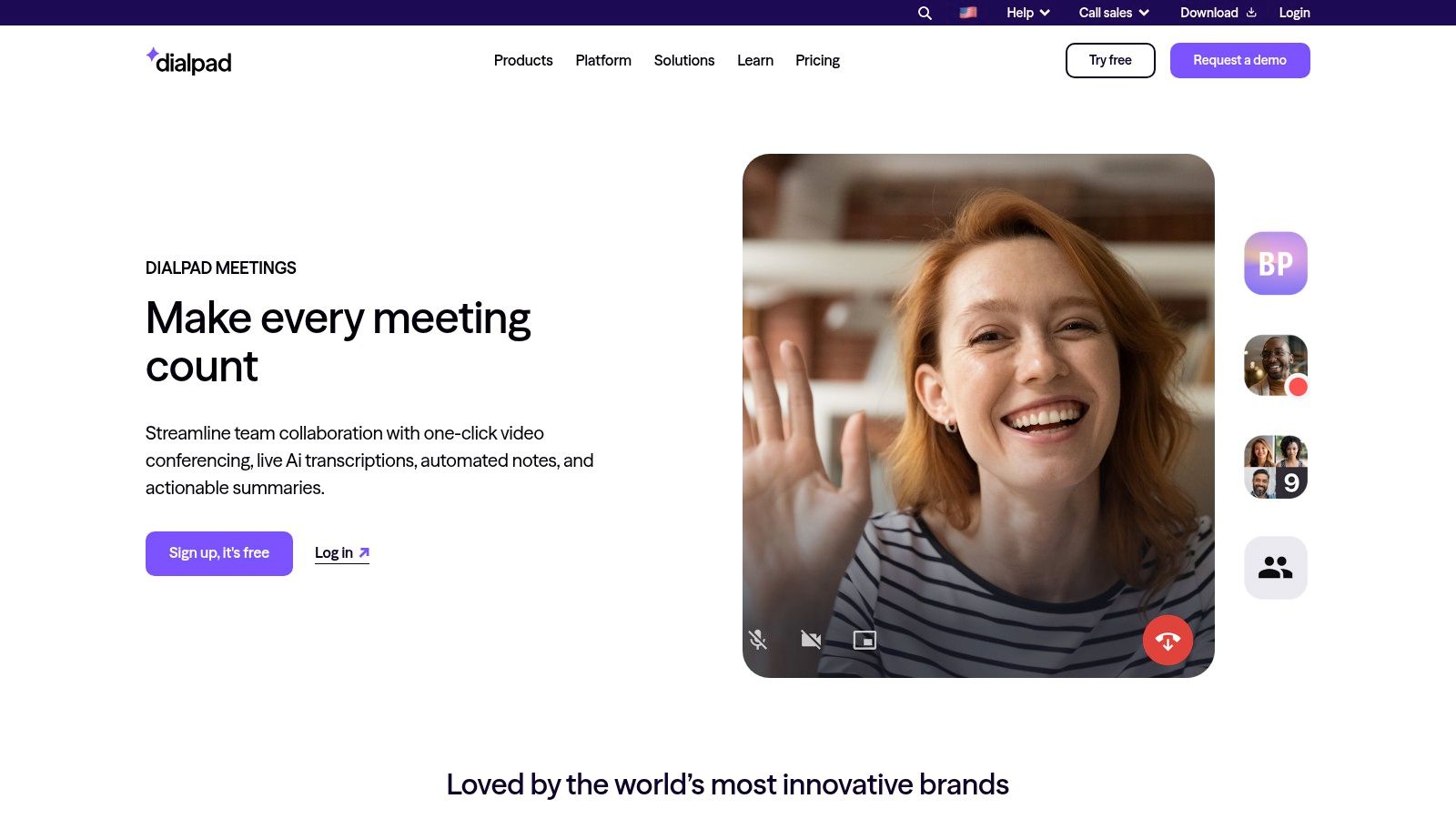
The platform focuses on making meetings more productive, not just possible. It eliminates common friction points, such as requiring PINs to join a call, and provides a clean, user-friendly interface. While its free plan is more limited in participant numbers than some rivals, its unique AI-driven features make it a strong contender for the title of best video conferencing software for teams focused on efficiency and follow-through.
Key Features & Performance
- AI-Powered Voice Intelligence: Provides real-time transcriptions, post-meeting summaries with action items, and sentiment analysis to gauge call dynamics.
- HD Video & Screen Sharing: Delivers reliable video quality and standard collaboration tools like screen sharing and in-meeting chat.
- PIN-Free Joining: Participants can join meetings with a single click, simplifying the process for external clients or less tech-savvy team members.
Pricing & Access
- Free Plan: Allows meetings up to 45 minutes with a maximum of 10 participants.
- Business Plan (Starts at $15/user/month): Removes time limits, increases participant count to 150, and unlocks advanced AI features, call recording, and integrations.
Our Take: Dialpad Meetings is the ideal choice for small teams and professionals who want their meeting tool to do more than just connect faces. The AI transcription and automated summaries are invaluable for staying organized on the road. While the 10-participant cap on the free plan is a limitation, the productivity gains offered by the paid plan justify the investment for many remote workers.
11. ClickMeeting
ClickMeeting carves out a specific niche by focusing intensely on webinar hosting, making it a powerful tool for businesses, educators, or anyone looking to present to a larger audience. While it functions perfectly well for standard team meetings, its real strength lies in features designed for structured online events. For remote workers or RV-based entrepreneurs who need to run product demos, online courses, or marketing presentations, ClickMeeting offers a level of polish and control that general-purpose platforms often lack.
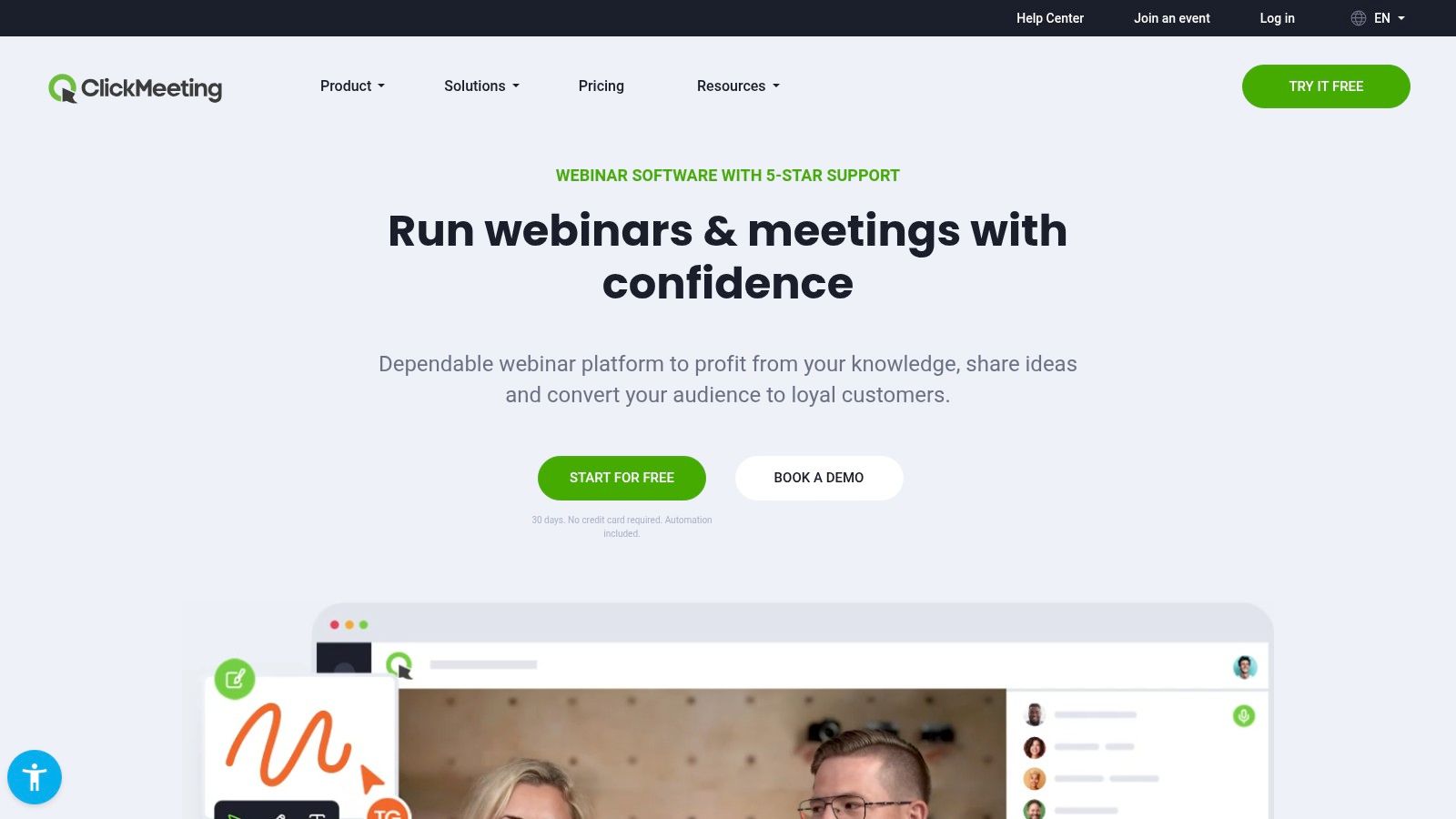
This platform provides a comprehensive suite for managing the entire webinar lifecycle, from pre-event registration pages to post-event analytics and automated follow-ups. Its user-friendly interface simplifies the process of creating a professional, branded event, making it one of the best video conferencing software choices for presentation-heavy roles.
Key Features & Performance
- Customizable Webinars: Add your own branding, create custom invitations, and design waiting rooms to provide a seamless brand experience for attendees.
- Audience Engagement Tools: Keep your audience locked in with interactive features like live polls, surveys, and moderated Q&A sessions.
- On-Demand & Automated Webinars: Record a presentation and set it to run automatically, creating an evergreen asset that can generate leads or educate customers around the clock.
Pricing & Access
- Free Trial: A 30-day free trial is available to test the platform's features with up to 25 attendees.
- Live Plan (Starts at $25/month, billed annually): For live events with up to 1000 attendees, includes most core webinar features.
- Automated Plan (Starts at $40/month, billed annually): Adds automated and on-demand webinar functionality to the Live plan's features.
Our Take: ClickMeeting is the ideal choice for remote professionals whose work revolves around presenting rather than simple collaboration. If your goal is to host polished, engaging webinars without a steep learning curve, its specialized toolset is well worth the investment over a more basic video call app.
12. Adobe Connect
Adobe Connect carves out its niche in the video conferencing market by focusing on deep customization and persistence, making it an excellent choice for structured training, education, and webinars. Unlike platforms that offer a one-size-fits-all meeting room, Adobe Connect allows hosts to design and brand their virtual spaces with specific layouts and interactive "pods" for polls, chats, and file sharing. For remote teams or educators who repeatedly use the same format, its persistent rooms are a major time-saver, as the layout and content remain set up between sessions.
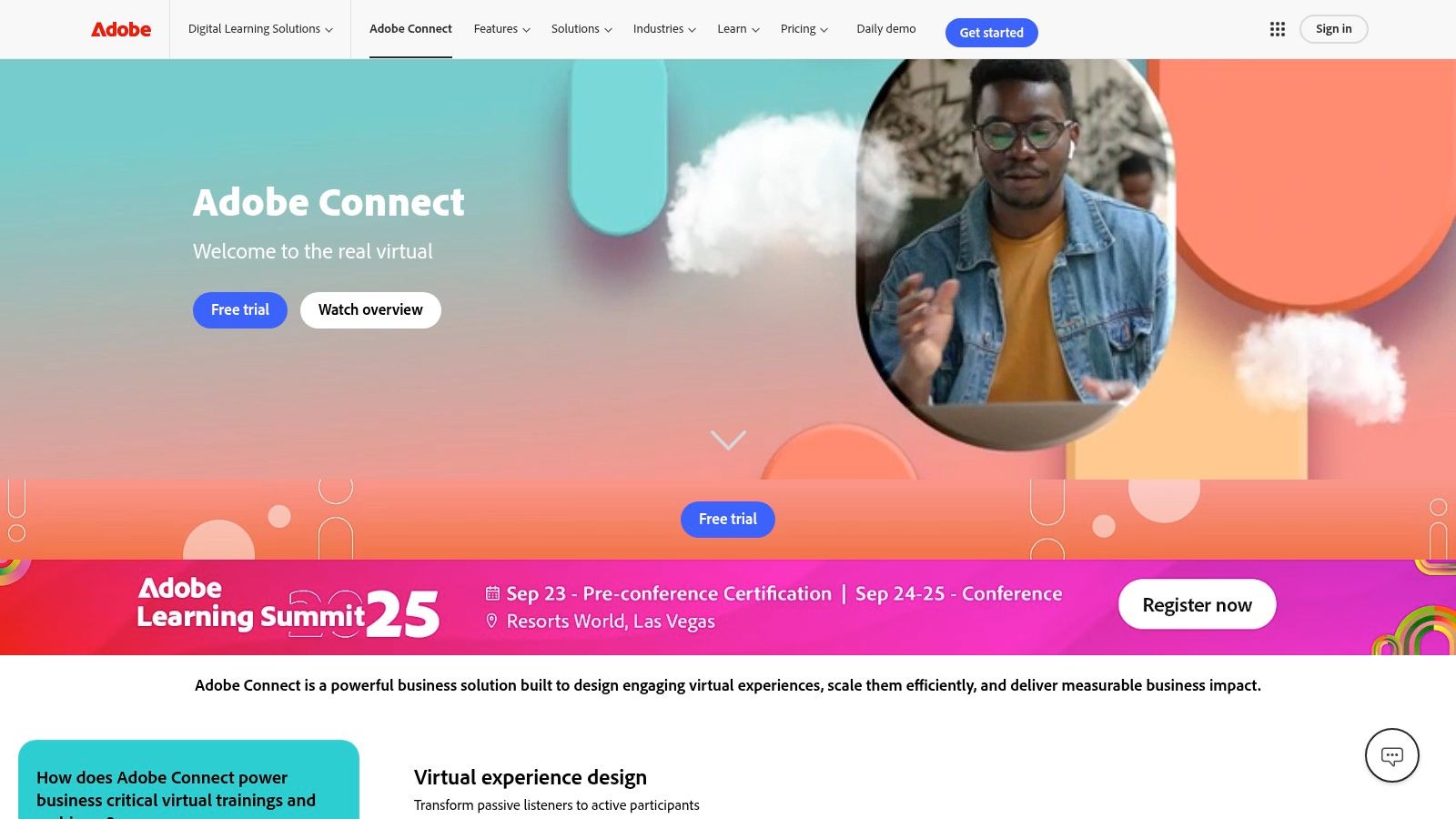
This level of control makes it one of the best video conferencing software options for formal presentations or any scenario where user engagement is paramount. While it might be overkill for a quick, informal chat, its powerful feature set is invaluable for creating immersive learning and collaborative environments. However, its extensive capabilities come with a steeper learning curve compared to more straightforward tools.
Key Features & Performance
- Customizable Layouts: Design your meeting room by arranging various pods (chat, Q&A, polls, notes) to fit the session's specific needs.
- Persistent Virtual Rooms: Rooms retain their layout, content, and chat history, eliminating the need for setup before each meeting.
- Enhanced Interactivity: Features like breakout rooms, interactive whiteboards, and in-depth polling tools foster active participation.
- LMS Integration: Seamlessly connects with Learning Management Systems, making it a top choice for corporate training and higher education.
Pricing & Access
- Meetings (Starts at $50/user/month): For up to 25 participants, focused on online meetings and collaboration.
- Webinars & Learning Plans: Custom pricing is available for larger audiences and advanced virtual classroom features. A free trial is also offered.
- Website: https://www.adobe.com/products/adobeconnect.html
Our Take: Adobe Connect is a powerhouse for anyone conducting formal training or large-scale webinars. Its persistent, highly customizable rooms are a standout feature. While the complexity and price point might deter users seeking a simple meeting tool, its capacity for creating engaging, structured virtual experiences is unmatched.
Top 12 Video Conferencing Software Comparison
| Platform | Core Features ✨ | User Experience ★★★★☆ | Value Proposition 💰 | Target Audience 👥 | Unique Selling Points 🏆 | Price Points 💰 |
|---|---|---|---|---|---|---|
| Zoom | HD video, breakout rooms, recording | User-friendly, scalable | Reliable & secure | Small to large meetings | Widely adopted, robust security | Free limited; paid tiers |
| Microsoft Teams | MS365 integration, team channels, file collab | Comprehensive, secure | Best for MS365 users | Businesses using MS ecosystem | Deep MS365 integration, collaboration tools | Included in MS365 plans |
| Google Meet | Google Calendar, live captions, dial-in | Simple, easy setup | Free with Google Workspace | Google Workspace users | No install needed, strong Google integration | Free with limitations |
| Cisco Webex | HD video, noise cancellation, breakout sessions | High quality, secure | Enterprise-grade solution | Large orgs, enterprises | Strong security, scalable for big meetings | Higher cost |
| GoTo Meeting | HD video, drawing tools, mobile apps | User-friendly, reliable | Professional support | SMEs and professionals | Strong support, reliable performance | Free limited; paid tiers |
| RingCentral Video | HD video, team messaging, AI noise reduction | High-quality, secure | Unified communication | RingCentral users, enterprises | AI-powered noise reduction, unified platform | Paid plans, costly for small teams |
| BlueJeans | Dolby Voice audio, integrations | Exceptional audio quality | Reliable conferencing | Enterprises needing audio quality | Dolby Voice audio, smart meeting features | Higher cost |
| Zoho Meeting | Video/webinars, moderator controls, RSVP | Affordable, easy integration | Cost-effective for Zoho users | Small businesses using Zoho | Zoho ecosystem integration, no downloads | Affordable plans |
| Jitsi Meet | End-to-end encryption, no accounts | Free, privacy-focused | Completely free & secure | Privacy-conscious & tech savvy | No account needed, open-source | Completely free |
| Dialpad Meetings | AI voice intelligence, call recording | User-friendly, AI-enhanced | AI-powered insights | Small to medium teams | AI voice intelligence, no PINs required | Free limited; paid tiers |
| ClickMeeting | Webinars, polls, branding, marketing integrations | User-friendly, interactive | Webinar focused solution | Educators, marketers | Webinar branding, marketing tool integration | Paid plans, higher cost |
| Adobe Connect | Custom layouts, persistent rooms, LMS integration | Highly customizable | Interactive training & webinars | Training & education | Persistent rooms, high customizability | Paid plans |
Final Thoughts
Navigating the landscape of video conferencing software can feel like plotting a cross-country route with an outdated map. With a dozen powerful contenders, each offering a unique set of features and performance characteristics, the "best" choice is rarely a one-size-fits-all solution. This is especially true for RVers, digital nomads, and rural remote workers who contend with the unique challenges of variable internet connectivity, from campground Wi-Fi to cellular 5G and satellite links. Throughout this guide, we've dissected the top platforms, moving beyond marketing claims to provide a practical analysis tailored for life on the move.
Our exploration revealed a clear hierarchy of needs. For some, raw performance on a shaky connection is the top priority, making tools like Zoho Meeting or the lightweight Jitsi Meet particularly appealing. For others, deep integration into an existing work ecosystem is non-negotiable, positioning Microsoft Teams and Google Meet as front-runners for businesses already invested in their respective suites.
Key Takeaways for Selecting Your Tool
Choosing the best video conferencing software for your specific situation requires a clear understanding of your daily demands. Here are the most critical takeaways to guide your decision:
- Prioritize Performance on Unstable Networks: If you frequently find yourself in areas with less-than-ideal internet, your focus should be on platforms known for their low bandwidth requirements. Tools like Zoho Meeting and GoTo Meeting have built strong reputations for maintaining call stability even when connectivity falters. Don't discount Jitsi Meet for its browser-based simplicity and minimal resource usage, which can be a lifesaver on a weak signal.
- Evaluate Your Collaboration Needs: Are your meetings simple one-on-one check-ins, or do you require robust collaboration tools? For complex projects involving screen sharing, whiteboarding, and breakout rooms, powerhouses like Zoom, Microsoft Teams, and Cisco Webex offer the most comprehensive feature sets.
- Consider Long-Term Costs and Scalability: A free plan might be sufficient for now, but consider your future needs. As your business grows or your team expands, you may require features like longer meeting durations, cloud recording, or advanced analytics. Evaluate the paid tiers of platforms like RingCentral Video and ClickMeeting to ensure they offer a viable upgrade path that aligns with your budget.
- Don't Overlook Specific Features: Sometimes, a single feature can be the deciding factor. For instance, if you heavily rely on creating and sharing meeting recordings for training or asynchronous communication, it's essential to scrutinize the capabilities of each platform. You can further compare recording options between Zoom and Google Meet to see which platform better suits your needs for storage, quality, and accessibility. Similarly, Adobe Connect excels in creating persistent, customizable virtual rooms ideal for ongoing training and education.
Making the Right Choice for Your Remote Work Lifestyle
Ultimately, the process of selecting the best video conferencing software is a personal one, rooted in your individual workflow, budget, and technical environment. We recommend a practical, hands-on approach. Shortlist two or three platforms from our guide that seem to fit your profile. Take advantage of their free trials and put them to the test in your real-world environment.
Start a call from a state park using your cellular hotspot. Join a meeting from a coffee shop with notoriously slow Wi-Fi. See how each application handles screen sharing, test its mobile app's usability, and gauge its impact on your device's battery life. Only through this direct, practical testing can you confidently determine which tool will be a reliable partner on your remote work journey, rather than a source of constant frustration. The right software should feel invisible, empowering you to connect and collaborate seamlessly, no matter where the road takes you.
A powerful video conferencing tool is only half the battle. To ensure crystal-clear calls and a stable connection from your RV or rural home, you need a reliable internet solution built for the challenge. SwiftNet Wifi provides high-speed, dependable internet designed specifically for travelers and underserved areas, ensuring your chosen software performs at its best. Get the consistent connection you need to work and connect from anywhere with SwiftNet Wifi.

